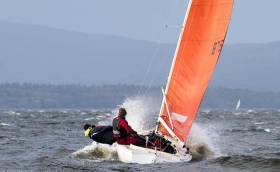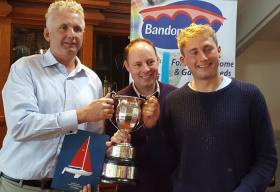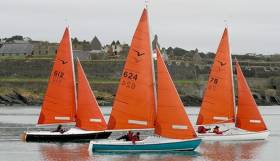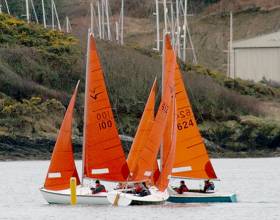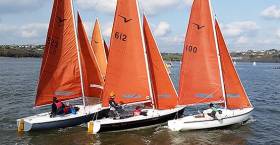Displaying items by tag: squib
On the weekend of 6-7 May, Nigel and Jack Grogan (Current UK Squib National Champions and directors of Hyde Sails) came to Ireland to coach members of the Irish Squib Forum writes Vincent Delany. The coaching took place at the Royal St George Yacht Club, and in Dun Laoghaire Harbour.
In addition to large numbers of Dun Laoghaire based sailors, we had visitors from the Belfast Lough Squib Fleet, from Wexford, Lough Derg and Howth fleets.
We started with indoor coaching on Saturday evening, when the weather outside was bitterly cold with the second continuous week of north eastern gales.
What was learned on Saturday was put into practice on Sunday morning, in bright sunshine but no wind. All the Squibs, both privately owned boats and club boats, were checked for rig setup, general equipment, and race preparation.
Current thinking on rig tension is radically different from what was in fashion a few years ago, and sail design has been modified accordingly.
On Sunday afternoon, by which time a sea breeze had developed, we held at least a dozen races over a short windward leeward course over a period of two hours.
Among the people at the coaching sessions were helmsmen and crews. Although some people remained for the indoor coaching only, eighteen took part in the harbour based activities. Of these seven were ladies and thirteen were men.
On the race course, Perfection, Periquin, Little Demon, Sidewinder, Astrix, Tais, Fox, Why Not, Tears in Heaven, and Summer Wine enjoyed the champagne sailing conditions. Crews were swopped from boat to boat to add some spice to the occasion. We would love to tell you what the Squib teams learned- but if you weren’t there, you will have to wait until next year.
Frosty Start to Frostbite Sailing at Kinsale Yacht Club
29 hardy entrants in 3 fleets were on the start line today for the first day of the Kinsale Yacht Club Frostbite Series kindly sponsored by Osean74 writes Michelle Kennelly. The marina was white with frost as the Squibbers slid down to their boats to rig while the Toppers, Lasers and 420 cracked the ice off boat covers to go afloat.
A sunny but calm morning saw the AP/1 go up at 10.55hrs. However the wind filled in and the first racing got under way at 12.00hrs. The weather decided, in typical Irish style, to throw everything at the fleets. The first beat for all 3 fleets was slow – to the point that the S Flag was flown - then a squall passed through which saw winds of over 23 knots, wiping out half the Topper Fleet, followed by very pleasant 8 – 10 knots. A strong ebbing tide also added to the challenge.
First off were the mixed dinghies with the fleet comprising of Laser Full Rig, Laser Radial, Laser 4.7 and a 420. Micheal O’Suilleabhain & Michael Carroll in the 420 sailed an excellent first race and lead all the way. Sean Collins in a Laser Radial came in 2nd with Hugo Morgan also in a Laser Radial in 3rd. In the 2nd race Sean Murphy in a Laser Full Rig got a great start and held on to the lead to come in clear ahead of the fleet by over 3 mins with Sean Collins taking 2nd on corrected time and Micheal & Michael in 3rd. The series is tied at the top which will make for great racing over the coming weeks.
This is only the 2nd year that the Topper Fleet has sailed in KYC so it was great to have six on the water so early in the season. For some it was their first time racing and the conditions were very challenging. The first race started in ideal conditions for them however the sudden squall with 23 knots of wind wiped out some and the first race has two finishers with Maeve Buckley 1st and Francesca Lewis in 2nd. In the second race Ellie Cronin was well ahead to take first place, however 2nd and 3rd place were hotly contested between Maeve, Francesca and David Carter. David just pipped Francesca on the line to take 2nd and Francesca came 3rd.
The Squib Fleet had 15 boats on the start line today with Scooby Do, Diarmuid Wrenne & Mary Coyne, travelling from Glandore Harbour Yacht Club to join in the fun. Several new additions/returns o the KYC Squib Fleet took to the water today. Welcome back to Pulpo, looking stylish in her new livery, with Commodore Tom Roche at the helm & Irish National Squib Champion Finbarr O’Regan crewing. Welcome to Flora with Dave Ross & Bobby Nash, Plan B with Pat Salter & Richard Callanan and Mucky Duck with Michael O’Sullivan & Sean O’Sullivan. Viking Gold is also back with Jeff Cochrane at the helm and Claire Cochrane crewing.
The 1st race saw Allegro, Colm Dunne & Rob Gill, dominate by staying out of the strong ebbing tide and looking like the clear winner until an unfortunate error saw them try to finish on wrong side of the Committee Boat which let Pulpo in to take 1st, with Sensation, Denis & Brid Cudmore, in 2nd. Allegro tacked swiftly on realising their error to take 3rd. Lessons in reading SI’s being provided to all next week.
The 2nd race saw Sonny P, Tony Doody & Josephine Manley, get off to a flying start. The fleet split after rounding the windward mark and Fuggles, Jeff Condell & Eoghan O’Mahony, sailed lower and took advantage of the tide to get to leeward mark first. Fuggles held position for the next lap with Allegro coming in 2nd. Eala, John & Bill Thullier sailed a great race to come in a close 3rd.
Here’s to five more weeks of fun and competitive Osean74 Frostbite racing in Kinsale.
Squib Traveller Trophy Goes to Kinsale Yacht Club Duo
Jeff Condell and Jeff Cochrane from Kinsale Yacht Club sailing In Squib 812 'Fuggles' are the winners of this year's Irish Squib Travellers Trophy.
The annual keelboat class award is for Squibs which travel to the regional and national championships.
It is necessary to compete in two regional championships and in the National Championships to qualify to win the trophy.
They concluded their achievement with a 3rd place at the inland championships in Dromineer on Lough Derg last weekend.
Bumper Squib Entry of 22 at Lough Derg Yacht Club
Squibs from all over Ireland converged on Lough Derg Yacht Club at Dromineer at the weekend. Three came from the Royal North of Ireland in Belfast Lough, two from Killyleagh Yacht Club on Strangford Lough, two from Royal St George Yacht Club, and one from Royal Irish Yacht Club and one from the National Yacht Club in Dun Laoghaire, One from Howth Yacht Club, three from Kinsale Yacht Club, one from Galway Bay Sailing Club and plenty of Squibs from the home club. Only for a huge rugby funeral, there would have been many more boats from Kinsale. All in all, the entry of 20 Squibs equalled the Irish Championship in Kinsale a few weeks earlier.
Racing on Saturday was held on Lough Derg in the racing area North of the Corrikeen Islands, with windward-leeward courses. Initially there was almost no wind, so competitors paddled to the race area, and racing was postponed till a force two breeze from the south-south-east kicked in. In race one ‘The Worm’ sailed by Sam Lyness and Erk Heyes from RNIYC played the shifty wind and flat water to their advantage, to win the first race from Jack and Jill Roy’s ‘Kanaloa’ from NYC and ‘Fuggles’ sailed by Jeffs Condell and Cochrane who were using the new ‘Olimpic Sails.’ These prototype Squib sails depend on really bar tight rigging, unlike the normal set up for Squibs.
By race two the wind had swung to the south-east, again was light and shifty. This time the order was ‘The Worm’, ‘Fuggles’ and Gordon Patterson and Ross Nolan’s ‘Quickstep III.’
There was a quick break, for lunch afloat. By race three the wind was in the east, with the windward mark near the Tipperary shore. ‘Quickstep III’ skilfully handled the shifting winds, which were particularly trickey near the windward mark, and won from ‘The Worm’ and Simon Watson and Brian Kelly’s ‘Volante’ from Killyleagh.
‘The Worm’ nailed the start of the fourth race, with the same wind strength and direction, and held a decent lead from the fighting pack behind. It was Judy Hamilton and Vincent Delany’s ‘Greeb’ who stole second place from ‘Volante’ and ‘Quickstep’. This was the significant result which decided the championship.
On Saturday evening the Lough Derg club, and The Whiskey Still’s hospitality lived up to their reputations. ‘The Worm’ allegedly downed more gin and tonics than his overnight racing score.
On Sunday the forecast was for fourteen knots gusting to twenty-seven knots. Racing was held near Ryan’s Point, with the windward mark off Urra. This would test the skills of the sailors. In the first race the wind only got up to about 12 knots. ‘Quichstep III’ took the gun (in a race with winds shifting up to twenty degrees), from Des Clayton and Paul Henry in ‘Inismara’ in what was almost a photo finish. ‘The Worm’ took fifth place which was enough to give him the championship.
By the final race the wind, as forecast, was very gusty, which allowed the Squibs to plane on the running legs, and produced a few spectacular broaches. This time it was ‘Fuggles’ which won from ‘Quickstep’ and Colm Dunne and Emmet Ryans ‘Allegro’.
Thanks go to Commodore David Meredith and his team for organising a great regatta, and to Lt. Cdr. John Leech for acting as OOD in difficult conditions.
For full results see below.
Kinsale Yacht Club Duo Win Irish Squib Title on Home Waters
Only three points separated the top three overall in yesterday's Bandon Co-op Irish National Squib Championships 2016 at Kinsale Yacht Club.
After six races sailed and one discard Cian and Finbarr O'Regan's local entry was the overall winner by a single point from Royal North of Ireland's John Driscoll and David Cagney.
Third overall was another KYC entry, Fuggles sailed by Jeff Condell Jeff Cochrane.
The 20–boat fleet inlcuded entries from Killyleagh YC, Royal Ulster and Lough Derg YC and Howth Yacht Club but none from the Dun Laoghaire fleet
Results are downloadable below.
Squib Nationals Postponed Till October Over Poor Weather
#Squib - Poor weather forecast for this weekend has prompted Kinsale Yacht Club to postpone the scheduled Squib Nationals till 1-2 October.
Seven races had been planned for the Old Head of Kinsale and the Sovereign Islands in what would be the club's third time hosting the event, as previously reported on Afloat.ie.
The club has also pushed back the annual Mary P trophy race till Saturday 27 August on account of the wet and windy outlook for this weekend.
Kinsale Yacht Club host the Irish Squib National Championships for the third time in August. They hosted it first on 2008 and again in 2013 when KYC members James and Bruce Mathews in Mucky Duck took the title.
Seven races are planned between the Old Head of Kinsale and the Sovereign Islands in the Bandon Co–Op Sponsored event. Last year, the Irish title went to UK visitors, father and son crew Nigel and Jack Grogan of the Royal Corinthian Yacht Club at Burnham–on–Crouch, when the event was sailed at Howth Yacht Club.
Kinsale Yacht Club Frostbite Titles Decided
With the leaders in both the Squib and Laser fleets away today the Kinsale Yacht Club Frostbite title was up for the taking. There was no wind at all on the course and so the AP was flown. At 11.25am the decision was made to start, wind was out of the West, about 4 – 5 knots. However it soon became apparent that what little wind there was had faded away, with only 1 boat near the windward mark after 20 mins PRO, John Stallard, called for the N flag and the race was abandoned. Thus began the wait...... It was bitterly cold on the water and the laser fleet decided to abandon the racing and the 4 headed back to shore. Not so the Squib Class – with at least two boats in the running they were anxious to get some racing in.
All marks were lifted and the N over A were about to be hoisted when John called “stop”. Eureka – the wind was filling in from the South East. Finally at 12.50pm – after over 2 hours on the water we got the racing underway. Viking Gold, Jeff Condell & Nigel Dann, were held down at the pin end allowing Sedition, Neil Prendeville & Dominic Falvey, and Fagin, Cian & Finbarr O’Regan, clean starts. Sedition sailed a great beat and got to the windward mark first, closely followed by Fagin and Viking Gold. However Fagin and Viking Gold took advantage of Sedition having to go around the spreader mark again and set off down the run. Viking Gold took a lower line than Fagin and had to gybe for the mark, this allowed Fagin to extend his lead. John Stanley & Alastair Christie in Bateleur passed Sedition at the first windward mark and managed to stay ahead to take 3rd place.
The wind was now a steady 8 – 9 knots out of the SE and so at 13.23hrs a second race, this time with 3 laps of the course, got underway. Both Fagin and Viking Gold got caught by tide at the line which slowed their starts. Fagin tacked under Viking Gold and went up the right side of the course while Viking Gold stayed more to the left. Bateleur got a clean start and was following Fagin up the right. Fagin made the windward mark in the lead, Bateleur and Viking Gold were very close but some tactical tacking by Bateleur secured him the mark and he started down the run ahead. Fagin was in clear command of this race and now Bateleur and Viking Gold were battling for 2nd place. Bateleur took the higher line on the run and gybed early, which paid off and he was lifting in to the mark on port at speed while Viking Gold was gybing. This ensured a 2nd for Bateleur and Viking Gold came in 3rd. Fagin had done enough to take the overall title, Allegro came 2nd and Viking Gold was 3rd .
Many thanks from the Fleets to Bruce and June Matthews for not only sponsoring the event but also providing the committee boat, Destiny. To all the volunteers, both on Destiny and on the ribs many thanks from all the sailors who thoroughly enjoyed the event. Looking forward to the season ahead.
The Irish Squib National Championships are on in Kinsale this year. See you all 19 – 21st August for some excellent racing in the waters outside Kinsale Harbour.
Kinsale Yacht Club Frostbite Titles Up for Grabs
The third week of the Frostbites in Kinsale Yacht Club was run under testing conditions today. When the Committee Boat, got to the racing area there was barely 5 knots of breeze, compounded by the fact that it was out of the NE and there was a very strong tide ebbing, the windward leg was definitely challenging for the competitors.
9 Squibs were on the start line. 1st race saw Viking Gold, Jeff Condell and Jeff Cochrane, trying hard to hold his position at the Committee Boat end of the line but he got pushed OCS and had to go around. Allegro, Colm Dunne and Rob Gill and Fagin, Cliodhna and Finbarr O’Regan, were neck and neck for the first two legs. Colm came down on starboard on a higher line, Cliodhna ran a more direct line to the mark. However Colm jibed onto port and reached in at speed to take the mark and this was to prove a decisive move in the race. Viking Gold put in a great race and despite the recall managed to overhaul the fleet to take 3rd.
The wind picked up to 8 – 10 knots for the next 2 races which made the challenging beat a little easier. Allegro took command from the start by finding clean air on the line. Fagin and Viking Gold were tick tacking for 2nd place. John Stanley and Alastair Christie on Bateleur and Denis and Brid Cudmore on Sensation were not far behind. Fagin rounded the leeward mark ahead and secured 2nd. Viking Gold decided to come up to the finish line on the left side of the course and this paid off by securing him 3rd place ahead of Sensation and Bateleur.
The final race again saw an OCS, this time Fagin got squeezed over the line and had to come around. Allegro and Viking Gold both got clear starts, Allegro rounded the windward mark first and managed to hold the lead for the rest of the race. Bateleur rounded the windward mark in 3rd and had a very strong race. Despite the recall Fagin picked off the fleet one by one and with some serious hiking by Finbarr and great helming by Cliodhna just managed to get ahead of Bateleur on the last tack to the line to take 3rd. Next week Allegro is away so Viking Gold and Fagin have it all to play for.
The Laser Fleet saw only 3 competitors today as 1st & 2nd in the series are away training. Mathias Hellstern took command of each of the races to take 3 bullets, Chris Baker put in a steady performance to come 2nd each race with Nic Bendon taking 3rd. Hopefully next week will see a larger turnout of Lasers.
Lough Derg Yacht Club's freshwater regatta completed the 2015 one design season for the SB20s, Flying Fifteens, (see our earlier report here) and Dragons last weekend. The Squib class also counted the inland event as a Midland Championships.
With a combined turnout of 54–boats across the four classes and some tight races on Lough Derg there were some noteworthy winners including a second overall for debutante Squib campaigner (and London 2012 International Race Officer) Jack Roy sailing with daughter Jill. Squib winners, with by far the biggest fleet of 25 boats, were Jeff Condell and Jeff Cochran.
Full results for all classes below.





























